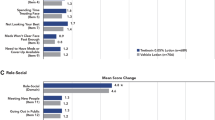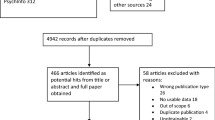Abstract
Background: The Acne-Specific Quality of Life Questionnaire (Acne-QoL) is a responsive, reliable and valid instrument developed to measure the impact of facial acne across four dimensions of patient QOL. Score changes on this instrument have been used to report statistically significant treatment advantages for a low-dose oral contraceptive (Estrostep®), containing norethisterone (norethindrone) acetate (NA) 1mg and ethinylestradiol (EE) [20, 30, 35mg] as compared with placebo in women with moderate acne vulgaris. However, the question remained if these statistically significant results were also clinically meaningful.
Objectives: To evaluate the statistically significant Acne-QoL benefits observed with NA/EE in terms of their clinical significance, and to compare the three different approaches for defining a minimal clinically important difference (MCID) for the Acne-QoL instrument.
Methods: Since the optimum method for estimating MCIDs has yet to be established, three different published approaches for determining MCIDs were applied and compared using data from two randomised, double-blind, placebocontrolled studies of the efficacy of NA/EE in the treatment of facial acne.
Results: Although the approaches differed substantially, the resulting MCID estimates were comparable. Specifically, the MCID estimates ranged from 0.50–10.3 mean change per item, depending on the domain. The results showed that the statistically significant treatment advantages for NA/EE were also clinically significant.
Conclusion: When applied to the change scores present, the results showed that the statistically significant treatment advantages for NA/EE were also clinically significant.








Similar content being viewed by others
Notes
The use of tradenames is for product identification purposes only and does not imply endorsement.
References
Layton AM. Psychological aspects of acne vulgaris. J Cutan Med Surg 1998; 2: 19–23
Jaeschke R, Singer J, Guyatt G. Measurement of health status: ascertaining the minimal clinically important difference. Control Clin Trials 1989; 10: 407–15
Maloney JM, Arbil DI, Flack M, et al. Use of a low-dose oral contraceptive containing norethindrone acetate and ethinyl estradiol in the treatment of moderate acne vulgaris. Clin J Womens Health 2001; 1: 123–31
Girman CJ, Hartmaier S, Thiboutout D, et al. Evaluating healthrelated quality of life in patients with facial acne: development of a self-administered questionnaire for clinical trials. Qual Life Res 1996; 5: 481–90
Martin AR, Lookingbill DP, Botek A, et al. Health-related quality of life among patients with facial acne: assessment of a new acne-specific questionnaire. Clin Exp Dermatol 2001 Jul; 26 (5): 380–5
Fehnel SE, McLeod LD, Brandman J, et al. Responsiveness of the Acne-Specific Quality of Life Questionnaire (Acne-QoL) to treatment for acne vulgaris in placebo-controlled clinical trials. Qual Life Res 2002 Dec; 11 (8): 809–16
Juniper EF, Guyatt GH, Willan A, et al. Determining a minimal important change in a disease-specific quality of life questionnaire. J Clin Epidemiol 1994; 47: 81–7
Osoba D, Rodrigues G, Myles J, et al. Interpreting the significance of changes in health related quality of life scores. J Clin Oncol 1998; 16: 139–44
Jones PW and the Nedocromil Sodium Quality of Life Study Group. Quality of life, symptoms and pulmonary function in asthma: long term treatment with nedocromil sodium examined in a controlled multicentre trail. Eur Respir J 1994; 7: 55–62
Norman GR, Sridhar FG, Guyatt GH, et al. Relation of distribu-tion- and anchor-based approaches in interpretation of changes in health related quality of life. Med Care 2001; 39: 1039–47
Guyatt GH, Juniper EF, Walter SD, et al. Interpreting treatment effects in randomized trails. BMJ 1998; 316: 690–2
Cohen J. Statistical power: analysis for the behavioral sciences. New York: Academic Press, 1977
Acknowledgements
This study was solely funded by Pfizer, Inc., manufacturers of Estrostep®.
Author information
Authors and Affiliations
Corresponding author
Rights and permissions
About this article
Cite this article
McLeod, L.D., Fehnel, S.E., Brandman, J. et al. Evaluating minimal clinically important differences for the acne-specific quality of life questionnaire. Pharmacoeconomic 21, 1069–1079 (2003). https://doi.org/10.2165/00019053-200321150-00001
Published:
Issue Date:
DOI: https://doi.org/10.2165/00019053-200321150-00001




